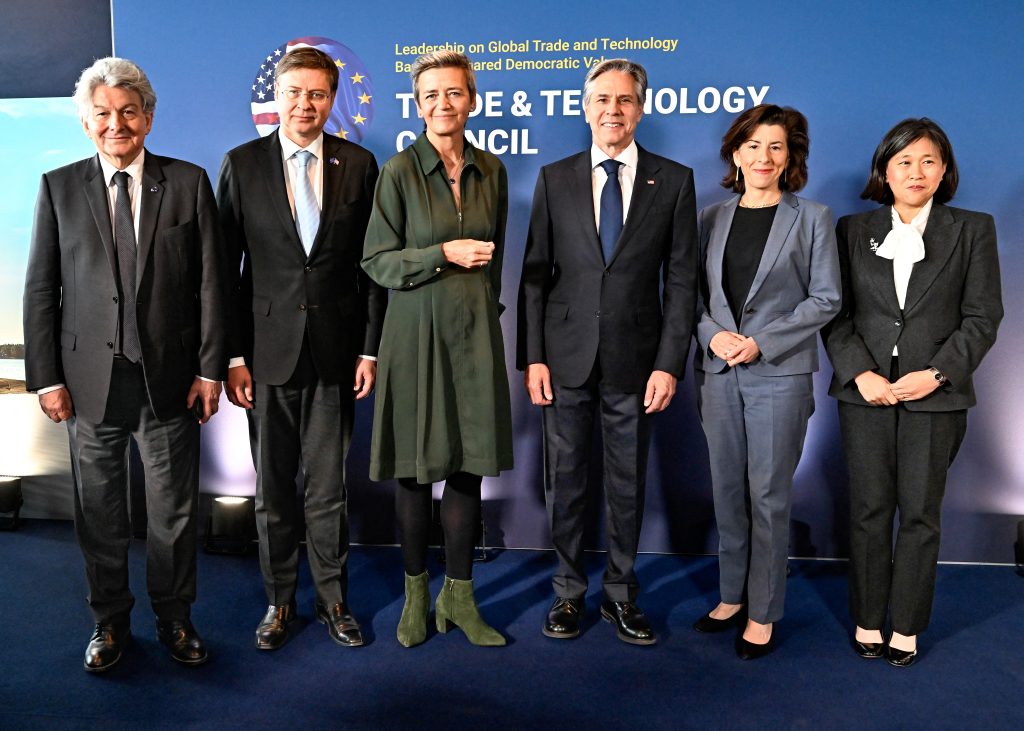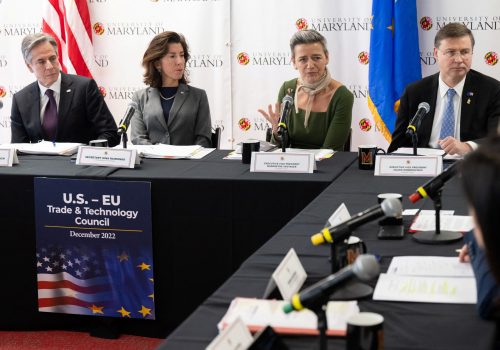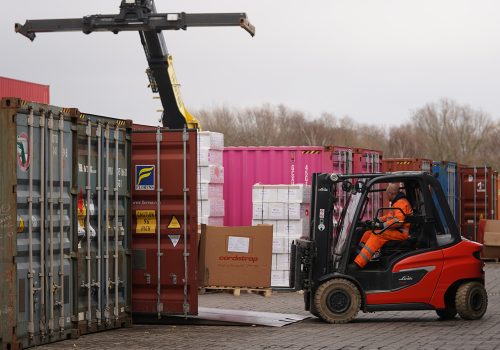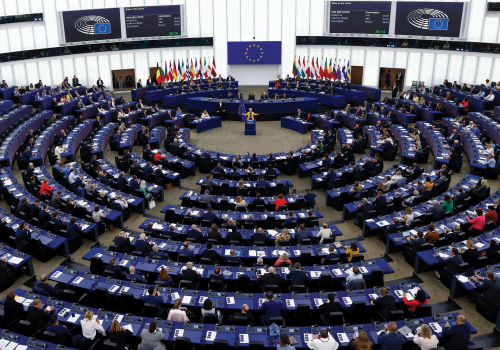SUMMARY
The need for the United States and the European Union (EU) to collaborate to address growing energy and resource security challenges, the climate emergency, and environmental degradation is more urgent than ever. The deadly heatwaves on both sides of the Atlantic are another reminder of the need for immediate action. However, progress on the US-EU Trade & Technology Council’s (TTC) green agenda has been slow. At the fourth ministerial meeting, which took place in Sweden on May 31, the United States and the EU reiterated their commitment for collaboration. Now, this commitment must be put into action.
Building on input received during multiple stakeholder workshops and conversations in the first half of 2023, this policy memo outlines options for how the TTC should work to align climate efforts with joint security and geoeconomic goals, leverage technologies for accelerating the green transition, and secure access to the resources required for making the transition a reality.
Background
The TTC was launched in June 2021 to coordinate approaches to key global technology, economic, and trade challenges, basing its policies on shared democratic values. The TTC has tremendous potential to accelerate the green transition, strengthen transatlantic energy and resource security, and benefit consumers, businesses, and workers.
The discussions within the TTC have led to several relevant initiatives. These include efforts to build resilient semiconductor supply chains, cooperate on emerging technologies, and create standards to govern the circular economy. Specific efforts such as the Talent for Growth Task Force and the Transatlantic Initiative on Sustainable Trade, are also advancing these aims. Moreover, the TTC has identified other areas for joint action, including green public procurement, greenhouse gas assessment methodologies, and supply chain traceability.
However, overall progress on the TTC’s green agenda has been slow when compared to other workstreams. This is partly explained by capacity constraints and diverging US and EU approaches to aligning the green transition with industrial competitiveness. However, the May meeting in Sweden reinforced the desire for strengthened collaboration, for example, on technology standards, artificial intelligence research, sustainable trade and supply chains, and export controls. The meeting also reaffirmed the role of the Clean Energy Incentives Dialogue in clean energy deployment, supply chain security, workforce development, and finding common ground around clean energy incentives.
To capitalize on this, the TTC should become central in helping the United States and the EU step up their joint efforts to address environmental challenges and enhance climate action, as well as energy security, through trade and technology solutions. The platform should help open the transatlantic market for products and services needed to accelerate the green transition.
Recommendations: From shared principles to joint action
1. To align climate and sustainability ambitions with security and geoeconomic goals, the TTC should:
- Find US-EU common ground on economic engagement with China amid competing priorities and geopolitical tensions. The group should map out differences in US and EU perspectives around de-risking vs. decoupling economic relations with China and reducing dependence for strategically important materials needed for the green transition. Meanwhile, it should identify specific areas where transatlantic differences on China strategy pose a threat to diversifying green supply chains.
- Explore ways to further enforce existing energy export controls against Russia. While the main purpose of export controls is to protect sensitive Western technologies from being used in ways that threaten international peace and security, a better implementation of this tool can lead to additional benefits for the green agenda and to weakening Russia’s abilities to weaponize energy. For example, Russia’s liquefied natural gas development and services are heavily reliant on imported components and skills. The TTC should establish a transparent US-EU database of trading trends which provide insight into suspicious or irregular trading activities, such as new trading routes for products, to flag possible export controls evasion.
- Ensure that green transition efforts also benefit third countries. In its May 2023 statement, the TTC committed to “undertake joint analyses of non-market policies and practices of third parties to better understand their impact on US and EU companies.” The United States and the EU should expand on this commitment to find ways to reduce adverse climate, environmental, and social impacts of their actions (e.g., resource extraction, recycling activities, and waste shipments) on other countries. Transatlantic collaboration in combatting forced labor in global supply chains, as agreed upon in May, is an important starting point, and this should be coupled with efforts to lift workers’ standards, especially in the mining and manufacturing sectors.
- Support Ukraine in the reconstruction and transformation of its energy sector. Ukraine’s reconstruction will be a complex, costly, and lengthy endeavor. The EU and the United States should use the TTC platform to explore ways to speed up the transition of Ukraine’s economy, including its food, mobility, and energy systems, and make them more sustainable and resilient. This will also provide an excellent opportunity to develop and deploy solutions for which the market is growing beyond Ukraine. The TTC should examine the role digital technologies can play in improving stakeholder coordination and eliminating redundancies in the provision of aid, vetting project applications, and ensuring that communities benefit equitably from investments.
2. To build on the power of technologies and develop common standards for the green transition, as well as energy and resource security, the TTC should:
- Coordinate on the development of digital product passports (DPPs) and enhance trade for digital services.
- Negotiators should explore the scope of information to be included in DPPs (which can be used to gather environmental and sustainability data on a product and its supply chains) and the stages for their rollout. This requires collaboration on transatlantic methodologies and standards across value chains, including on product recyclability and recycling processes, as well as policies that are shaping the recyclables trade.
- The development of DPPs should complement existing transatlantic efforts to improve the transparency of products’ climate and environmental footprints and improve information sharing in supply chains. In the longer term, DPPs could also capture products’ social impacts.
- The TTC should consider how DPPs could support ongoing efforts for climate action, such as the implementation of carbon border taxes.
- The United States and the EU should explore ways to enhance trade for digital services needed for improving energy, mobility, and food systems, as well as production and consumption patterns. They should exchange best practices and ways to enhance “product-as-a-service” business models.
- Work toward global standards for methane emissions management.
- The United States and the EU should commit to strong methane emissions standards bilaterally. This way, they can establish rules of the road for global initiatives while pioneering the technologies needed to bring methane abatement to scale.
- The TTC should support efforts, including under the Global Methane Pledge, to develop global standards for measuring, reporting, and verification (MRV) of methane emissions. The partners should look for ways to use the International Methane Emissions Observatory as the MRV data clearinghouse and promote the United Nations Environment Programme’s Oil & Gas Methane Partnership 2.0 as the universal standard for reporting.
- The partners should produce a list of the most effective technologies and best practices for emissions reduction. They should highlight how these technologies can improve data quality and transparency of lifecycle methane emissions in the energy, agriculture, and waste management sectors.
- Support the development and deployment of zero- and low-emission energy sources through common standards.
- Biogases and other low-carbon gases: The TTC should align gas quality specifications and certification systems, including for blending levels, to streamline production from various feedstocks and technologies.
- Hydrogen: The group should accelerate development and deployment of hydrogen value chains. This means working with distribution network operators, hydrogen producers, and potential buyers, such as steel manufacturers and utility providers, on the synchronization of hydrogen transportation standards and integration into existing systems where applicable. Particularly, the TTC should support efforts to synchronize matching, additionality, and deliverability standards for hydrogen. It should put strong focus on helping accelerate the development and deployment of hydrogen with the lowest carbon intensity across the value chain. However, in the near term, all hydrogen production methods can be considered as options to support its commercialization and uptake in meeting decarbonization and energy security goals.
- E-fuels: The TTC should establish e-fuels production standards for use in carbon-intensive, hard-to-abate sectors such as shipping and aviation. It should explore additional areas where e-fuel standards synchronization could be impactful and ensure that uptake of e-fuels does not lead to unintended consequences such as worsening air quality.
- Energy efficiency: The group should identify which energy efficiency technologies would benefit from standards alignment and how this could be achieved (e.g., with heat pumps). They should explore how digital solutions could be used across the Atlantic to optimize energy consumption in buildings and forge efficiencies in transport and mobility.
- Electric vehicles: The group should continue progress on standardizing electric vehicle charging infrastructure, building on the “Joint Technical Recommendations” published under the TTC’s Climate and Clean Tech Working Group. The standardization of charging infrastructure for trucks is a concrete demonstration of the possibilities that the US-EU collaboration offers for the green transition.
3. To ensure access to resources needed for the green transition, the TTC should:
- Focus on critical supply chains, materials, and products.
- Semiconductors: This is an area where the TTC has made some progress, with commitments to exchange information and market intelligence, and set up a joint early warning mechanism for disruptions in semiconductor supply chains. It should establish tangible goals and deadlines to move this workstream forward.
- Inflation Reduction Act/Net-Zero Industry Act: The TTC should build on the local content requirements discussion by expanding the number of minerals that would qualify under the forthcoming US-EU critical minerals agreement. The United States and the EU should also assess how their incentives compare across sectors. These efforts should complement the ongoing Clean Energy Incentives Dialogue.
- Circular economy: The group should explore ways to eliminate trade barriers for recycled materials. It should aim to create a market for secondary raw materials and for products and services that can contribute to a smarter use of resources needed for the green transition (e.g., by enhancing durability, reusability, repairability, and recyclability of materials and products). The TTC should start by collaborating on improving reusability and recyclability of electric vehicle batteries, and in boosting innovation on plastic recycling and alternative plastics technologies.
- De-risking manufacturing: The TTC should support existing efforts to identify relevant and competitive actors in green manufacturing in Europe, the United States, and like-minded countries. It should use policies, investments, and other incentives to advance innovations in the manufacturing sector and diversify required supply chains for a resilient green transition. These efforts should complement measures under the European Chips Act and the US CHIPS and Science Act.
- Address financing barriers. The TTC should identify areas where the lack of credit ratings is impeding, for example, energy trade deals for businesses and suggest government schemes for guarantees. This is particularly relevant for large-scale clean energy and low-carbon energy projects.
- Train a workforce for the green transition. The TTC should evaluate Science, Technology, Engineering and Mathematics (STEM) training in the United States and Europe, then pinpoint opportunities for knowledge exchange. This should include improving training programs when there is a disconnect between the current and projected market demand for skills needed for the green transition. The partners should also exchange good practices in supporting a just transition that helps workers in affected sectors adopt new skills and thrive.
Olga Khakova is the deputy director for European energy security at the Atlantic Council’s Global Energy Center.
Annika Hedberg is the head of the Sustainable Prosperity for Europe Programme at the European Policy Centre.
This policy memo is a product of the “TTC Track-2 Dialogues” series, created by the Atlantic Council and the European Policy Centre to foster policy debate and stakeholder dialogue on the issues covered by the US-EU Trade and Technology Council. The series aims to connect US and EU stakeholders for discussions along three thematic tracks relating to the TTC’s priorities: (i) trade and supply chain issues; (ii) data and technology regulation, and (iii) the green transition. Each track consists of two separate workshops with transatlantic stakeholders, which are used to inform short policy briefs containing concrete recommendations for US and EU decision makers.
Further reading
Thu, Apr 20, 2023
The US-EU Trade and Technology Council: Assessing the record on data and technology issues
Issue Brief By
The TTC must keep its forward-looking gaze, but also take steps to address challenging regulatory issues, either by oversight or direct discussion, or it will lose the essential support among stakeholders that can keep US engagement in the TTC alive.
Fri, Dec 2, 2022
Policy memo: How the EU and US should overcome their trade and supply-chain disputes
New Atlanticist By
Ahead of the next meeting of the US-EU Trade and Technology Council, here are five tests for the EU and United States to show progress on the trade and supply-chains agenda.
Wed, Nov 2, 2022
Digital sovereignty in practice: The EU’s push to shape the new global economy
Report By Frances Burwell, Kenneth Propp
What does the European Union's push for "digital sovereignty" mean in practice? Frances Burwell and Ken Propp provide an update to digital sovereignty and its transatlantic impacts.
Image: US Secretary of State Antony Blinken, Executive Vice President of the European Commission for An Economy that Works for People Valdis Dombrovskis, U.S. Trade Representative Katherine Tai, EU Internal Market Commissioner Thierry Breton, European Commission Vice President Margrethe Vestager and U.S. Secretary of Commerce Gina M. Raimondo attend a meeting, in Lulea, Sweden May 31, 2023. Jonas Ekstromer/TT News Agency/via REUTERS



